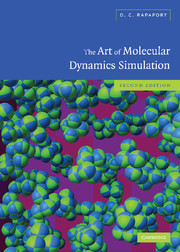Book contents
- Frontmatter
- Contents
- Preface to the first edition
- Preface to the second edition
- About the software
- 1 Introduction
- 2 Basic molecular dynamics
- 3 Simulating simple systems
- 4 Equilibrium properties of simple fluids
- 5 Dynamical properties of simple fluids
- 6 Alternative ensembles
- 7 Nonequilibrium dynamics
- 8 Rigid molecules
- 9 Flexible molecules
- 10 Geometrically constrained molecules
- 11 Internal coordinates
- 12 Many-body interactions
- 13 Long-range interactions
- 14 Step potentials
- 15 Time-dependent phenomena
- 16 Granular dynamics
- 17 Algorithms for supercomputers
- 18 More about software
- 19 The future
- Appendix
- References
- Function index
- Index
- Colophon
6 - Alternative ensembles
Published online by Cambridge University Press: 28 February 2011
- Frontmatter
- Contents
- Preface to the first edition
- Preface to the second edition
- About the software
- 1 Introduction
- 2 Basic molecular dynamics
- 3 Simulating simple systems
- 4 Equilibrium properties of simple fluids
- 5 Dynamical properties of simple fluids
- 6 Alternative ensembles
- 7 Nonequilibrium dynamics
- 8 Rigid molecules
- 9 Flexible molecules
- 10 Geometrically constrained molecules
- 11 Internal coordinates
- 12 Many-body interactions
- 13 Long-range interactions
- 14 Step potentials
- 15 Time-dependent phenomena
- 16 Granular dynamics
- 17 Algorithms for supercomputers
- 18 More about software
- 19 The future
- Appendix
- References
- Function index
- Index
- Colophon
Summary
Introduction
The equations of motion used in MD are based on Newtonian mechanics; in this way MD mimics nature. If one adopts the purely mechanical point of view there is little more to be said, but if a broader perspective is permitted and MD is regarded as a tool for generating equilibrium states satisfying certain specified requirements, then it is possible to modify the dynamics and address a broader range of problems. But at the outset it must be emphasized that no physical meaning is attributed to the actual dynamics, and the approach is merely one of computational convenience for generating particular equilibrium thermodynamic states, although – and this is not an attempt to extract any such meaning – the deviations of the motion from the truly Newtonian may in fact be extremely small.
Conventional MD differs from most experimental studies in that it is the energy and volume that are fixed, rather than temperature and pressure. In statistical mechanical terms, MD produces microcanonical (NVE) ensemble averages, whereas constant-temperature experiments correspond to the canonical (NVT) ensemble; if constant pressure is imposed as well, as is generally the case in the laboratory, it is the isothermal–isobaric (NPT) ensemble that is the relevant one. While the choice of ensemble is usually one of convenience at the macroscopic level since (away from the critical point) thermal fluctuations are small, for the microscopic systems studied by MD the fluctuations of nonregulated quantities can be sufficiently large to make precise measurement difficult.
Information
- Type
- Chapter
- Information
- The Art of Molecular Dynamics Simulation , pp. 153 - 175Publisher: Cambridge University PressPrint publication year: 2004
Accessibility standard: Unknown
Why this information is here
This section outlines the accessibility features of this content - including support for screen readers, full keyboard navigation and high-contrast display options. This may not be relevant for you.Accessibility Information
- 1
- Cited by
